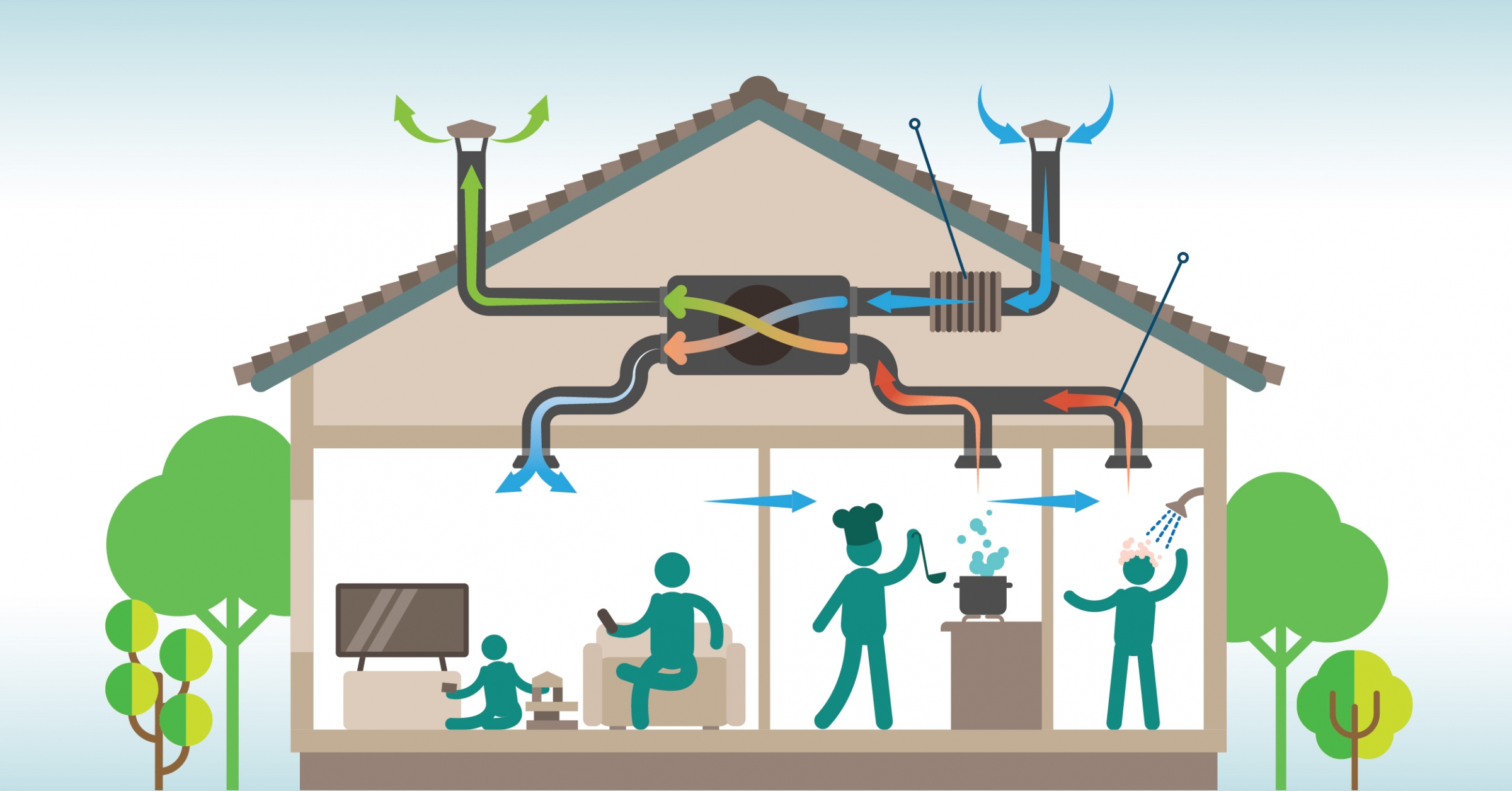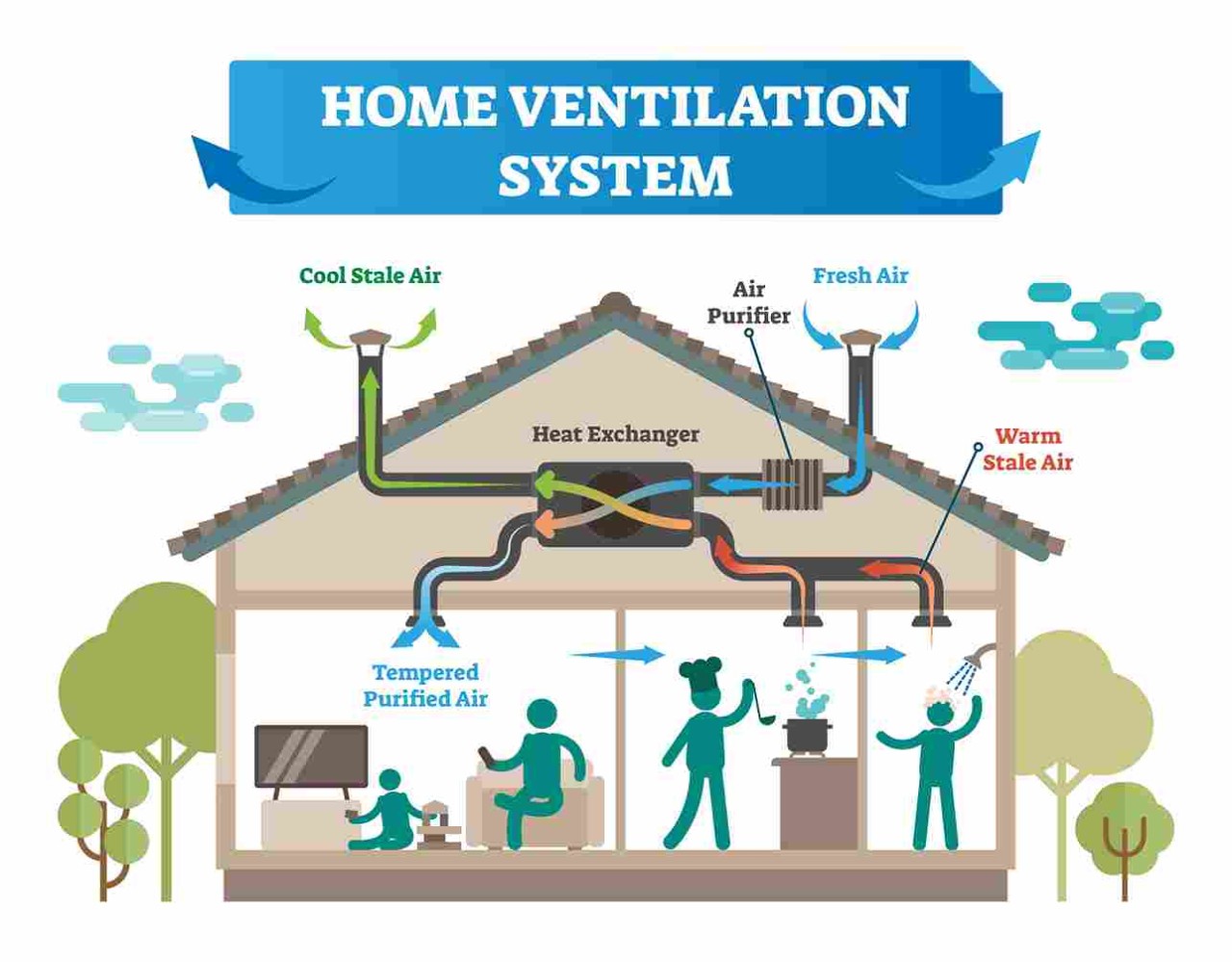Common Indoor Pollutants and How Home Ventilation Melbourne Reduces Them
Exploring Cutting-edge Solutions for Optimal Home Ventilation Systems
Home ventilation plays a vital role in maintaining health and wellness and comfort within living spaces. With innovations in technology, ingenious remedies are arising to enhance these systems. Smart air flow, power healing ventilators, and advanced filtering are improving how air quality is managed - Home Ventilation Melbourne. Nonetheless, the combination of these innovations questions regarding their effectiveness and flexibility in diverse home environments. What effects do these advancements hold for future living standards?
The Value of Home Ventilation for Health and Convenience
Often forgotten, home air flow plays an important duty in preserving both health and wellness and convenience within property areas. Ample ventilation is essential for the circulation of fresh air, which assists to dilute interior pollutants such as unpredictable natural substances, irritants, and odors. Without appropriate airflow, these pollutants can build up, causing respiratory system concerns and other health issue. In enhancement, efficient air flow adds to regulating moisture levels, stopping mold growth and architectural damage. By ensuring a balanced exchange of air, locals can appreciate an extra pleasurable interior setting, improving overall wellness. Moreover, appropriate air flow can enhance power performance by lowering the requirement for extreme home heating or cooling, inevitably resulting in lower energy costs and an extra sustainable living area.
Smart Ventilation Solutions: Harnessing Modern Technology for Performance
Smart ventilation systems represent a significant innovation in home air management, leveraging IoT integration for boosted control. These systems not only promote power efficiency yet also supply remote monitoring capabilities, allowing individuals to enhance their indoor settings perfectly. By harnessing technology, home owners can accomplish better air quality while reducing energy usage.
IoT Assimilation Benefits
How can IoT assimilation change conventional ventilation systems right into extremely reliable smart solutions? By including Web of Points (IoT) modern technology, air flow systems can attain real-time tracking and control, boosting their operational effectiveness. Sensing units positioned throughout a home gather data on air temperature, humidity, and top quality, enabling automated changes based on current problems. This instant responsiveness causes enhanced interior air top quality and convenience levels. Furthermore, IoT-enabled systems can connect with various other wise home devices, creating a natural ecosystem that optimizes power use. Users can additionally accessibility and manage their ventilation systems remotely via smart devices, supplying benefit and increased control. Overall, IoT integration represents a significant advancement, bringing knowledge and versatility to conventional ventilation practices.
Power Effectiveness Features
As power effectiveness becomes a vital emphasis in contemporary home layout, advanced ventilation systems offer innovative attributes that considerably reduce power intake. These smart air flow systems make use of sensing units to keep an eye on indoor air temperature level, high quality, and moisture levels, instantly changing air movement to maintain excellent conditions. By utilizing power recuperation ventilators (ERVs), they capture and reuse energy from outbound air, decreasing heating and cooling demands. Variable speed followers further improve effectiveness by readjusting their operation based on real-time needs, stopping unneeded energy waste - Home Ventilation Melbourne. Additionally, programmable timers and occupancy sensing units guarantee that air flow operates only when required, contributing to lower utility bills. Collectively, these features represent a substantial innovation in developing energy-efficient and lasting living settings
Remote Surveillance Capacities
What benefits do remote surveillance capacities offer modern-day home air flow systems? These abilities permit property owners to track indoor air quality and system efficiency in genuine time, improving general effectiveness. By offering data on air, humidity, and temperature level contaminants, wise ventilation systems allow proactive changes, ensuring perfect problems. In enhancement, remote surveillance promotes upkeep notifies, recognizing possible problems prior to they rise, therefore minimizing repair work prices and downtime. Individuals can access system analytics through mobile applications, enabling hassle-free control even when far from home. This technological assimilation not only advertises energy effectiveness but additionally contributes to a much healthier living atmosphere. Inevitably, remote monitoring abilities represent a significant innovation in home ventilation, lining up with the expanding demand for wise home technologies.
Power Healing Ventilators: Maximizing Energy Savings
Energy recuperation ventilators (ERVs) play an important duty in boosting home power efficiency with reliable heat exchange. By moving thermal energy in between inbound and outgoing air, these systems markedly decrease general energy usage. This cutting-edge strategy not only maintains indoor air high quality yet also adds to reduce energy expenses.
Effectiveness of Warmth Exchange
While preserving interior air high quality is essential for wellness and convenience, the effectiveness of heat exchange in energy healing ventilators (ERVs) plays a vital role in optimizing energy savings. The primary feature of an ERV is to transfer heat and dampness between incoming and outward bound jet stream, which maximizes indoor conditions while reducing energy loss. High-efficiency warm exchangers can significantly decrease the Learn More Here load on home heating and cooling down systems by recovering power that would certainly or else be lost. The effectiveness of these systems is usually measured by their core temperature currency exchange rate, which can vary based upon style and products utilized. By concentrating on sophisticated warmth exchange modern technologies, homeowners can boost their air flow systems, resulting in boosted energy efficiency and price reductions with time.
Decreased Energy Consumption
Decreasing energy intake is an essential benefit of energy recuperation ventilators (ERVs), as they effectively reuse thermal energy from worn down air. By moving warm in between incoming and outgoing air streams, ERVs lessen the demand for added heating or cooling, bring about significant energy savings. This process not just decreases utility costs however also decreases the environmental effect connected with higher energy usage. In enhancement, ERVs maintain regular indoor air quality without compromising thermal comfort, developing a well balanced living environment. By integrating ERVs into home air flow systems, homeowners can accomplish better energy efficiency, enabling a sustainable method to indoor air management while taking advantage of reduced energy bills. Eventually, ERVs stand for a compelling solution for energy-conscious consumers.
Advanced Purification Technologies for Cleanser Indoor Air
As interior air top quality becomes significantly recognized as an important part of health and well-being, advanced filtration technologies are emerging as vital tools for ensuring cleaner atmospheres. These innovations include high-efficiency particulate air (HEPA) filters, turned on carbon filters, and electrostatic precipitators, each made to properly capture air-borne pollutants, allergens, and unpredictable natural compounds (VOCs) HEPA filters can trap fragments as small as 0.3 microns, considerably minimizing allergens like allergen and family pet dander. Turned on carbon filters excel in adsorbing odors and chemical vapors, adding to a fresher interior environment. Additionally, electrostatic precipitators use electric costs to get rid of bits, providing an energy-efficient choice. By incorporating these advanced purification systems, property owners can boost interior air top quality and promote much healthier space.
The Role of Sensors in Maximizing Airflow and High Quality
How can sensing units transform the management of interior air quality? Sensing units play a necessary function in boosting air flow and boosting indoor settings. By constantly monitoring aspects such as humidity, temperature level, and levels of contaminants, they provide real-time information that notifies here ventilation systems. This details enables computerized adjustments to air flow, ensuring appropriate blood circulation and lessening the build-up of contaminants. Furthermore, progressed sensing units can discover details air top quality issues, triggering prompt reactions to improve convenience and health. The combination of these devices into air flow systems permits a more responsive and effective administration approach, minimizing power intake while maintaining suitable air quality. Ultimately, sensors work as an essential part in developing healthier indoor areas with exact air movement law.
Incorporating Air Flow With Smart Home Equipments
While lots of property owners seek benefit and performance, incorporating air flow systems with wise home innovation uses an ingenious option to handling indoor air high quality. By linking ventilation units to clever home centers, citizens can automate air high quality surveillance and control air movement based upon real-time data. These systems can reply to adjustments in contaminant, moisture, and temperature levels, guaranteeing optimal interior conditions. Smart thermostats can function in tandem with ventilation systems to boost power effectiveness, minimizing prices while maintaining comfort. House owners can likewise from another location regulate their ventilation setups with mobile applications, providing adaptability and comfort. Ultimately, this assimilation not just simplifies management yet considerably improves the general living setting, making it a useful enhancement to modern homes.
Future Patterns in Home Ventilation Solutions
Arising technologies and enhanced awareness of indoor air high quality are forming the future of home ventilation services. One substantial trend is the integration of fabricated intelligence, enabling systems to change air movement based upon real-time information and tenancy patterns. Additionally, energy healing ventilators are obtaining traction, giving efficient air exchange while minimizing energy loss. The use of green materials and layouts is additionally on the rise, lining up with sustainability objectives. Smart sensors that keep an eye on toxins and moisture degrees are coming to be standard, allowing property owners to maintain excellent interior atmospheres. Additionally, scalable and modular systems are arising, offering customizable choices for various home sizes and configurations. Home Ventilation Melbourne. Together, these developments promise to enhance comfort, efficiency, and wellness in household rooms
Often Asked Questions
How Usually Should I Tidy My Home Air Flow System?

The regularity of cleansing a home air flow system varies based on use and setting. Normally, it is suggested to clean up the system every 3 to 6 months to maintain perfect air top quality and system effectiveness.
Can Poor Ventilation Cause Mold And Mildew Growth Inside?

What Are the Indicators of Inadequate Home Ventilation?
Indicators of inadequate home air flow include persistent smells, raised humidity degrees, condensation on windows, noticeable mold and mildew development, and a general sensation of stuffiness. These indications commonly suggest that air flow is not enough for keeping a healthy interior setting.
Exactly How Can I Enhance Air Flow in Older Houses?
To boost ventilation in older homes, one may consider installing exhaust followers, making use of natural airflow via windows, sealing gaps for much better air control, and including air cleansers to enhance indoor air high quality properly.
Are DIY Ventilation Solutions Effective and Safe?

Smart ventilation, power recovery ventilators, and advanced purification are improving just how air top quality is managed. As energy efficiency ends up being an important focus in contemporary home style, progressed air flow systems supply cutting-edge attributes that significantly minimize power intake. By incorporating ERVs right into home ventilation systems, house owners can accomplish greater power efficiency, enabling a lasting technique to indoor air monitoring while profiting from reduced energy expenses. The assimilation of these tools into ventilation systems permits for a much more efficient and responsive administration technique, reducing power intake while preserving excellent air quality. While several homeowners seek convenience and performance, incorporating air flow systems with smart home technology supplies an ingenious service to managing interior air quality.